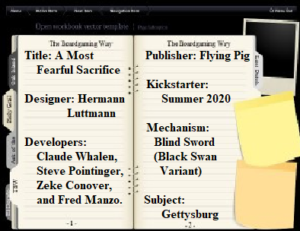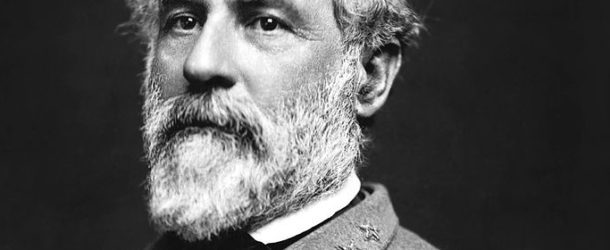Or “This Is Why We Playtest a Lot”
By Claude Whalen:
 Thousands of books have been written on Gettysburg, it seems that everyone has an opinion one way or another. Personally I have always thought that if the Rebels had “fought to win” and “not to lose”, they had a decent chance of beating the Army of the Potomac. I recently finished my first test of the Grand Battle scenario and I had some intriguing results.
Thousands of books have been written on Gettysburg, it seems that everyone has an opinion one way or another. Personally I have always thought that if the Rebels had “fought to win” and “not to lose”, they had a decent chance of beating the Army of the Potomac. I recently finished my first test of the Grand Battle scenario and I had some intriguing results.
The scenario is a free-wheeling one without any terrain victory points. The only terrain that counts for anything is each armies’ Line of Communication hex (Baltimore Pike and Cashtown Pike entry hexes). If the opposing side holds this hex at the end of any of the three days, they have achieved an Automatic Victory. Since the odds of that happening are slim, the real goal is to destroy your opponent’s army and/or force him off of the field.
My play had three clear segments to it, some VERY unlikely heroes and one surprising twist that set the tone for the full 3 Days. That being said, let’s dive into what could have happened.
At 9 am on July 1st, Davis and Cutler clashed as Reynolds/Wadsworth had pushed this brigade up ahead. Cutler attacked first with the “Take Those Colors” card but got the worst of the fight when he pushed forward after his original successful attack. Davis counter-attacked, broke one of Cutler’s units, and then a “Rebel Yell” card drove the rest of Cutler off. The 10 am turn started with both sides licking their respective wounds and bringing more troops into position. In a clear difference from “The Devil To Pay”, the Union player has to march most of his first-day reinforcements across both maps and so both sides have to divert cards to keep those fresh troops moving up. Just as the 10 am turn was ending, a small squad of Confederate soldiers entered the game (no real counter for these guys, I just created this group for narrative purposes). After getting clear orders from General Lee, “Only shoot Generals wearing BLUE uniforms”, these men moved out and plunked Reynolds at the end of his allotted 90 minutes on the battlefield.
People assume that Reynolds died before 11 am so the game was playing true to history. Though I didn’t know it at the time, this was the turning point of my play for Day One, Day Two, and really the game itself. Before I go any further, the “Fog of War” card has a variety of results that occur depending on a die roll. Two of the events were “Union Leader loss” and “Confederate Leader loss” (due to the results of this test, those tables have been amended; you will see why).
After Reynolds got shot, the crack team of Rebel marksmen moved on looking for other Union Generals to pick off. Buford got shot at 11 am, which meant that the two superior-rated Union leaders on the field were now down. As in “The Devil’s To Pay”, Hancock can start rolling to enter the game at either 1 pm or the turn after Reynolds is shot (if Reynolds lives past 1 pm). Hancock missed his 1 pm roll but the Rebels didn’t, shooting Steinwehr at 1 pm. The XII Corps entered the game led by General Slocum, who is certainly NOT dragging his feet. Perhaps he should have hung back because the Rebel assassins find him and hit him at 4 pm. The only good news is that Hancock finally makes his roll and enters the game at 4 pm, thus ending the 5 hours in which the AoP didn’t have a CIC on the field. Lee rode on the field at 4 pm also (he missed his original entry roll at 3 pm but Lee is on fire today). Hancock rides up to the front lines, surveys the situation, learns of the leadership losses, and then starts trying to get the Union forces in some semblance of order. Unfortunately, nobody told Hancock to look out for the Rebel assassins so after his 90 minutes on the field, “Hancock the Superb” is now “Hancock the Drilled”. The Rebels start to get worried as the light is starting to fade and that is when they usually start to shoot the wrong Generals so they hurry up and shoot Steinwehr at 6 pm. Of course, Steinwehr was already shot so he actually re-enters the game (as things work out, he should have stayed down). Ticked off at their error, the squad takes more careful aim at 7 pm and smacks General Wadsworth.
As Day One progressed and the Fog of War card came out, I DID change the die during this string of Union losses but nothing helped. I rolled seven (7) Union General hits before the Rebels lost General Heth at 9 pm. Even worse, the Union only had three Superior ranked leaders and they all got shot before 5 pm on Day One. Needless to say, the Union had real difficulty putting a decent defense together and any offensive ideas were completely off the table. Replacement leaders have lower ratings and that often leads to Corps Commanders only giving orders to one Brigade at a time, which spells real trouble.
Meredith’s Iron Brigade had to be treated with respect but the rest of the I & XI Corps were getting beaten up and pushed back. At 4 pm though two things happened; Lee entered the game (as previously mentioned) and second, Dan Sickles showed up at the south edge of the south map. Meanwhile, Lee and Early push towards Culp’s Hill but they have to push remnants of the XI Corps aside. Howard had to make a decision, Cemetery or Culp’s Hill; he chose Cemetery Hill therefore Early waltzed up Culp’s unopposed. Howard needed help and he got it from the most unlikely of sources, Dan Sickles and Graham’s Brigade.
Think about that, Sickles saves Cemetery Hill! Dan focused on getting at least one fresh brigade up into the fighting by using his activation and any event card that could push him up Emmitsburg Road. Gordon’s fresh brigade advanced from Culp’s Hill and attacked Graham. Defensive fire shook Gordon and then Graham flat out beat Gordon in assault combat. Shocking, positively shocking!
Further south along Cemetery Ridge, Lee and Anderson team up to assault a weaker portion of the makeshift Union line. Units from Wright/Wilcox/Mahone/Posey charge the Union guns around the Copse of Trees and the Union line breaks. Slocum’s replacement saw the crisis and sent McDougall and Candy’s brigades to Mrs. Brown’s House to block the breakthrough. Late in the turn, Pender sends Scales to finish off Meredith’s 7-5 unit, which is crushed in assault combat (when your opponent rolls a 62 and you only get a 14, that usually spells trouble).
So late during the night of July 1st, Meade arrived and called for a conference with his Corps Commanders (only Howard and Sickles show up, everyone else is in the “who are you?” category). Meade learns that the Rebels hold Culp’s Hill and have a toehold on Cemetery Ridge. A wounded Hancock sends a message to “stay and fight it out”. Sickles, “Savior of Cemetery Hill”, also wants to stay. Dan may be a rash political General but he also is a persuasive speaker who can talk his way out of a lot of things. He manages to get Meade to stay yet they both might regret doing it.








